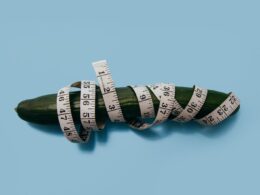While male condoms are widely available, there are also internal condoms, known as female condoms, that can be inserted in the vagina or anus to protect against pregnancy and sexually transmitted infections (STIs). (1)
These internal condoms contain lubricant on the inside. To use them, squeeze together the inner ring at the closed end and insert it into the vagina like a tampon.
What is a condom?
Condoms are a type of birth control and help protect against sexually transmitted diseases (STIs) and infections. They work by creating a physical barrier between the partners so that sperm can’t reach an egg and cause pregnancy. The condom also contains lubricant and spermicide, which destroys or degrades the sperm to make it less likely to enter the woman’s uterus and cause STIs and other issues.
Male condoms, which are used by men, look like a long sheath and are made of thin latex or polyurethane rubber. They have flexible rings on both ends. The closed end goes on the penis, and the open end is inserted into the vagina. The flexible ring or foam disc at the open end holds it in place inside the vagina during sexual activity. Female condoms are called femidoms, and they’re made of a soft sheath of polyurethane or other synthetic high-tech materials and are safe for people with latex allergies.
Both kinds of condoms are available at pharmacies and general merchandise stores, and some schools and health centers give out free male and female condoms to students or patients. You and your partner may need to experiment with different sizes, styles and textures of condoms before finding one that works best for both of you. Some condoms come with a built-in lubricant that can help make sex more comfortable for both partners. You can also use your own lubricant, but it should be water-based and not oil-based, which can damage the condom.
How do I use a condom?
Condoms are easy to use and don’t require any special preparation, but they must be used correctly to work. If they are not, there is a risk of pregnancy and sexually transmitted infections (STIs). It’s important to always check the expiration date on the packaging before using, and to open them carefully so that they don’t break. It’s also a good idea to use lots of lubricant, and make sure that the condom is rolled on right side out.
Female condoms are inserted into the vagina before foreplay and then a ring or poly frame at the closed end of the sheath is pushed down over the penis, ensuring that it doesn’t slip outside during sex. This can be quite a bit more awkward than male condoms, which only need to be rolled on and then positioned around the penis. It can also feel quite sticky, and may be uncomfortable for some people.
It’s a good idea to have a couple of pairs of female condoms on hand, as they are more likely to break than other types of condoms. It’s a good idea to store them in places that are not too hot or cold, and away from sharp objects that could rip them. They should be lubricated before they are inserted, and a water-based lubricant is best because other types of lube can eat into condoms and cause them to break.
Do I need a condom?
Condoms are an easy-to-use form of contraception and protect against pregnancy and sexually transmitted diseases (STIs). They act as a barrier by stopping sperm from entering the vagina, mouth or anus. They can also block the spread of genital ulcer diseases such as herpes and syphilis. Condoms are available in many different sizes, styles and types. Male condoms are usually made from thin natural rubber or polyurethane rubber, but there are also non-latex options for those who are allergic to latex. They are rolled onto an erect penis or can be placed on sex toys (such as dildos). Female condoms can also be put on before sex.
They are 98% effective at preventing pregnancy when used correctly, but they only work if they are worn from start to finish of intercourse. Condoms decrease the chance of infection from STIs such as chlamydia, gonorrhoea and HIV, but they don’t prevent all infections, including genital warts and monkeypox that can be spread through skin-to-skin contact.
If you and your partner choose not to use condoms, make sure that it is a mutual decision and you are both comfortable with the agreement. You should also be fully open to talking through your reasons for not using them and have a backup plan in place, such as using an alternative method of birth control or having safe, consensual sex without protection.
Are condoms safe?
Condoms, when used correctly every time you have sex, protect you from pregnancy and sexually transmitted infections (STIs) like HIV. They also protect against other STIs such as chlamydia and gonorrhoea, and help reduce your risk of herpes and genital warts. They don’t protect you against infections such as syphilis and monkeypox that can be spread through skin-to-skin contact.
But condoms can be less effective if you don’t use them properly or if they are old or worn. This is because they can break, slip, or get torn by rough surfaces or objects. You can avoid this by always using a new condom, making sure it is sealed tightly, and that there are no cuts or sores on your skin or penis before inserting it. You should also use a lubricant, like water, vaseline, baby oil or natural sex fluid. Avoid using oil-based lubricants such as petroleum jelly (Vaseline), suntan oils, cooking oils, butter and margarine, hand lotion, or massage oils – these can damage rubber. Spit and saliva can also be slippery enough to work as a lubricant, but make sure it is clean.
If you are using an internal condom, remember to remove it straight after sex, twist the large ring, and then throw it away in a bin. Never flush a condom – it could cause blockages in your pipes.









